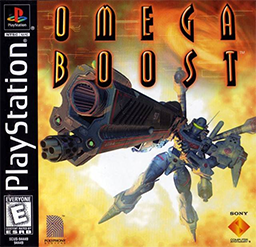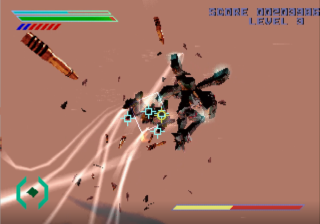GAME CLEAR No. 254 -- Omega Boost
video games game clear polyphony digital playstation ps1 sceOmega Boost (1999, PlayStation)
Developer: Polyphony Digital
Publisher: Sony Computer Entertainment
Clear Version: PS1
Clear Platform: PS1
Clear Date: 9/16/25

| Why should I care? |
|---|
| Being Polyphony Digital’s only non-racing effort makes this game an interesting curiosity, and it’s also pretty good in its own right. |
Carry out the mission carefully
A friend of mine and fellow Panzer Dragoon fan has been banging the drum to get me to play this spiritually similar lock-on shooter game for awhile now. What better time than right after I finished Gran Turismo, Polyphony Digital’s previous title? The Japanese studio took a bold pivot from simulation racing to mecha space battles (what is a mecha, after all, but the vehicle of the future?) with pretty good success by my estimation. Omega Boost is a stylish, pretty, and challenging shooter worthy of a spot in anyone’s PlayStation library.
As soon as you load up the disc, you are greeted with this game’s insane story. It opens with a dramatic live-action FMV. Manhattan and Tokyo have just been nuked off the face of the earth. Things are looking grim for humanity. You see, the AlphaCore AI has gone rogue and waged war on humanity. Ever plucky, humanity devises a plan to go back in time to stop AlphaCore. Before they can do that, AlphaCore goes back in time itself and embeds its code in one of the vacuum tubes of ENIAC, the first general-purpose digital computer, to try to preempt the humans. The humans are somehow aware of that and thus move to plan B, which involves sending a pilot with an uninfected vacuum tube to the timeshaft AlphaCore built on planet ETA so that he can go back in time and replace the infected tube. It’s a man vs. machine story even more riddled with time paradoxes than Terminator, but I can’t help but love it. Doesn’t hurt that the opening FMV features one of the game’s pair of (very cheesy) licensed needle drops as the cocksure pilot Lester Hemming takes off on his mission.
A great pilot deserves a great machine, though, and the eponymous Omega Boost does not disappoint. It’s a stylish mecha armed with a vulcan cannon that can fire shoot an automatic rifle or fire a flurry of lock-on missiles. By moving your cursor over enemies, you can tag them before firing your artillery. In most situations this is the best way to take out large groups of weaker enemies, and targeting weak points of bosses with this is also particularly effective. This is a significant chunk of what you’ll be doing combat-wise throughout the game, so it’s a good thing it’s a consistently satisfying mechanic. Scanning your cursor over a group of enemies while the lock-on beeps sound and the reticles appear just in time to fire a barrage of missiles as you begin to target the next set of bogeys feels great and keeps you constantly on your toes.

Omega Boost can fly in all directions for some 360-degree shooting action, making the lock-ons all the more important as you lose sight of enemies flying off screen. The other key to making this all work is Omega Boost’s scan feature, which automatically rotates the craft to face and approach nearby hostiles. You’ll be pressing L1 a lot to engage this, but as you learn the game, you will also discover when it is prudent to free-aim instead. There’s some resource management at play as well, as you can only lock on to as many enemies as you have missiles to fire at once. Earning a good score at the end of each stage (measured as a function of your speed in clearing a stage and what percentage of the total hostiles you managed to kill) will add missiles to your stock, encouraging sharp play. Add in a dash button for some quick evasion capabilities, and you’ve got Omega Boost’s full standard kit.
Its ace in the hole, however, is the Viper Boost. This ability charges with each enemy defeated, and when unleashed, Omega Boost flies at hyperspeed into any nearby hostiles, dealing massive damage until the meter drains. This is particularly useful for bosses (since it also grants invincibility) and is great for getting out of jams. It does add the “pixy” prefix to the title you earn at the end of a run, though, so the game seems to treat using it as something of an asterisk. Although I made use of it, I have no qualms with this, and I think it’s a nice way to challenge players to clear the game with just the fundamentals.
Mastery of the above mechanics is essential to clearing this game, which starts out deceptively easy. The game is just 9 levels long, and the first couple are almost comically breezy affairs. Before long, though, the challenge starts to creep. enemy formations become larger and more frequent. The bosses, which start as large but mostly non-threatening (and easy to target) become swifter and more offensive. The pesky BetaBoost, a mecha made by AlphaCore in an attempt to match Omega Boost, crops up from time to time and is no slouch either. In the game’s early space battles, freedom of movement is your friend, but as the combat becomes more terrestrial, evasion becomes more challenging, just as the enemies get more aggressive. Once Omega Boost enters the timeshaft, you’ve really got to keep your wits about you to not take massive damage from slamming into walls an obstacles.
It’s the final showdown with AlphaCore that really ate up my lives, though. The multi-level, multi-phase boss is absolutely no easy out, and it’s no help that its first form has a timer. On expiration, you’re dead. It’s a rather tough time to beat and quite frustrating — it’s one of my only major gripes with the design of this game.
It wouldn’t be so bad if it were not for the fact that this game imposes a limit of five lives. Run out, and it’s Game Over. This sort of classic design has mostly disappeared from games today (and for good reason), but I’ll admit it makes some sense in a shoot ’em up, a genre whose surrounding culture so values the “one-credit clear.”
It’s also alleviated somewhat by the game’s Zone Play mode, which allows you to practice any stage you have reached (and also features some bonus stages unlockable by performing various in-game feats). This allowed me to get multiple reps in on the final boss without having to restart the game each time — I’ll admit to having gotten tired of doing so by my third or fourth Game Over. When it was all said and done, I was able to beat the game without a single death and got a pretty solid rank. It’s not a design philosophy that will work for everyone, but it certainly did feel good to feel like I had achieved at least a base level of mastery of the game (not sure I’ll be going for a no-hit run anytime soon).
When you defeat AlphaCore (spoiler!), you’re rewarded with one more FMV cutscene to round things out, cementing this game as truly of its time. After the credits, you’re dropped back into the main menu, where (as always) the game’s other licensed track plays: Ostegolation by Static-X. Jam along as you review your high scores in the game’s stylish menus. Like Gran Turismo, that’s something this game has no shortage of: style. The aforementioned FMVs and music, the sharp menus, the cool robot designs, the soothing synthesized voice telling you “Omega Boost, it’s all set, carry out the mission carefully” before each level starts. It’s a game chock full of vibes and personality.
It’s a shame Polyphony Digital has never done something like this again. Omega Boost appears to me to be a game that would work so well as a VR revival. It’s pretty clear Sony’s interest in the tech is cooling, but I can tell you I’d buy it. Wishful thinking, I suppose, but at least the original Omega Boost will always be there for me if I want to take another quick run through its battalion of bots.